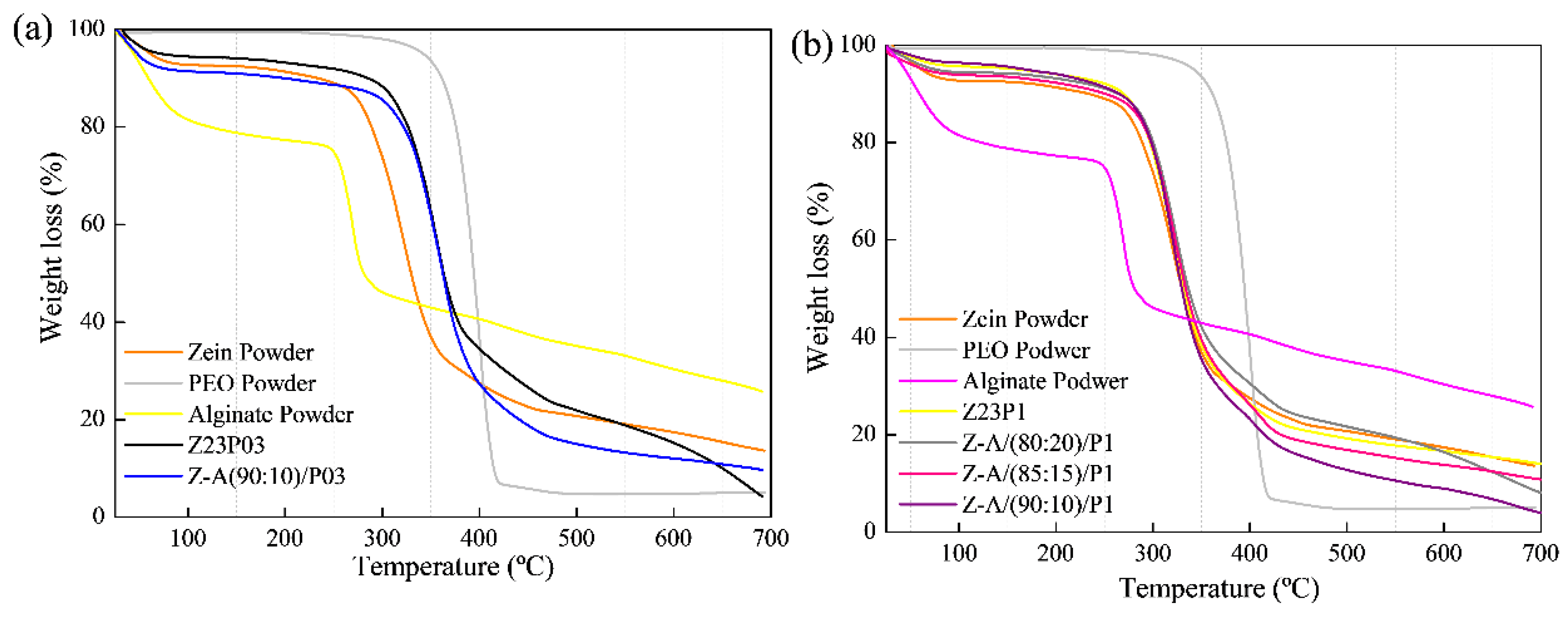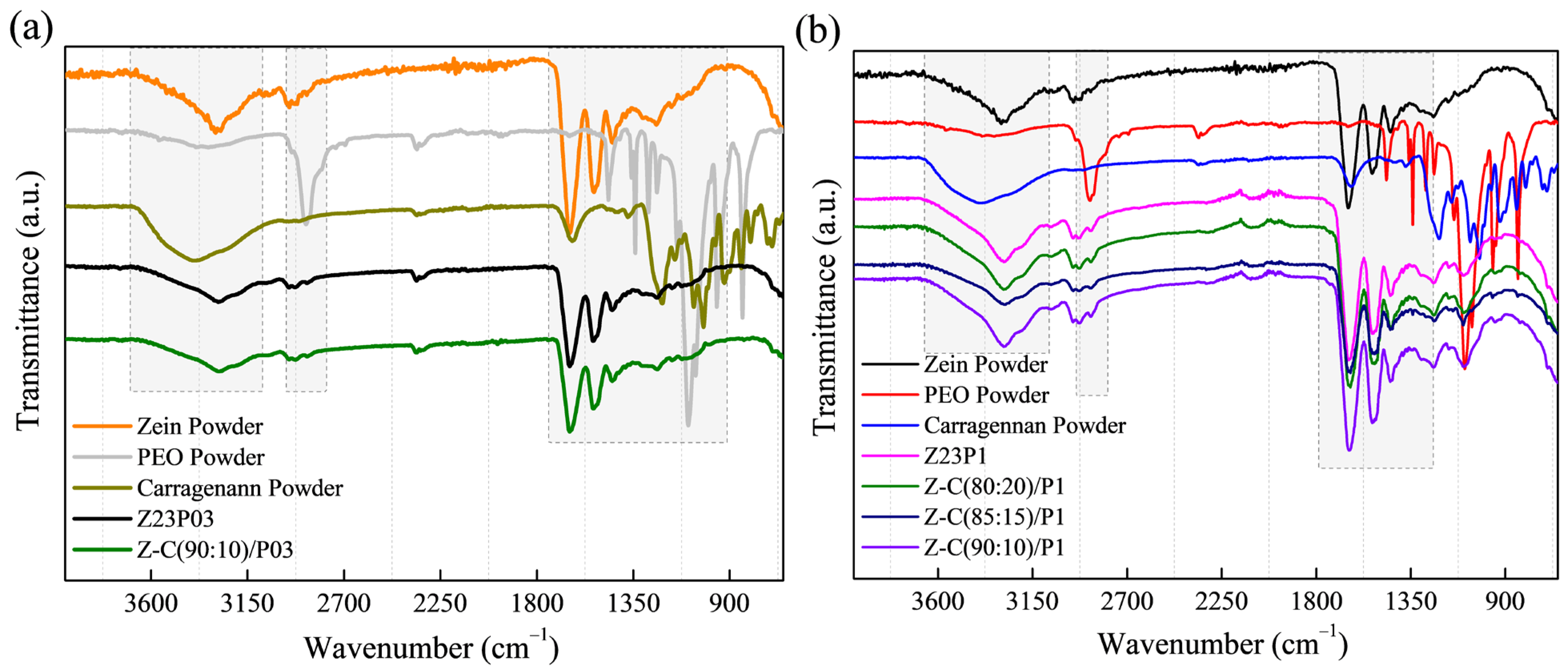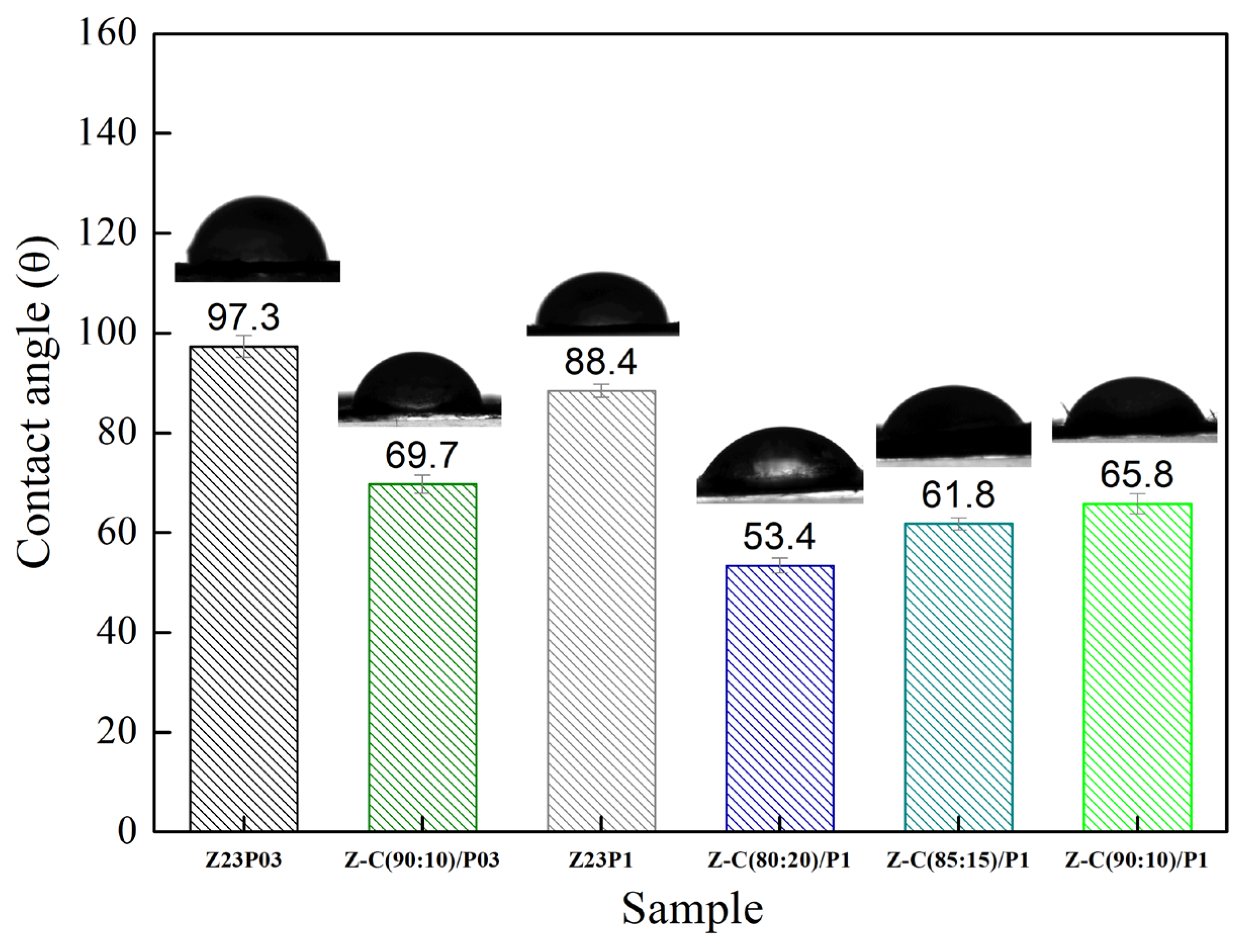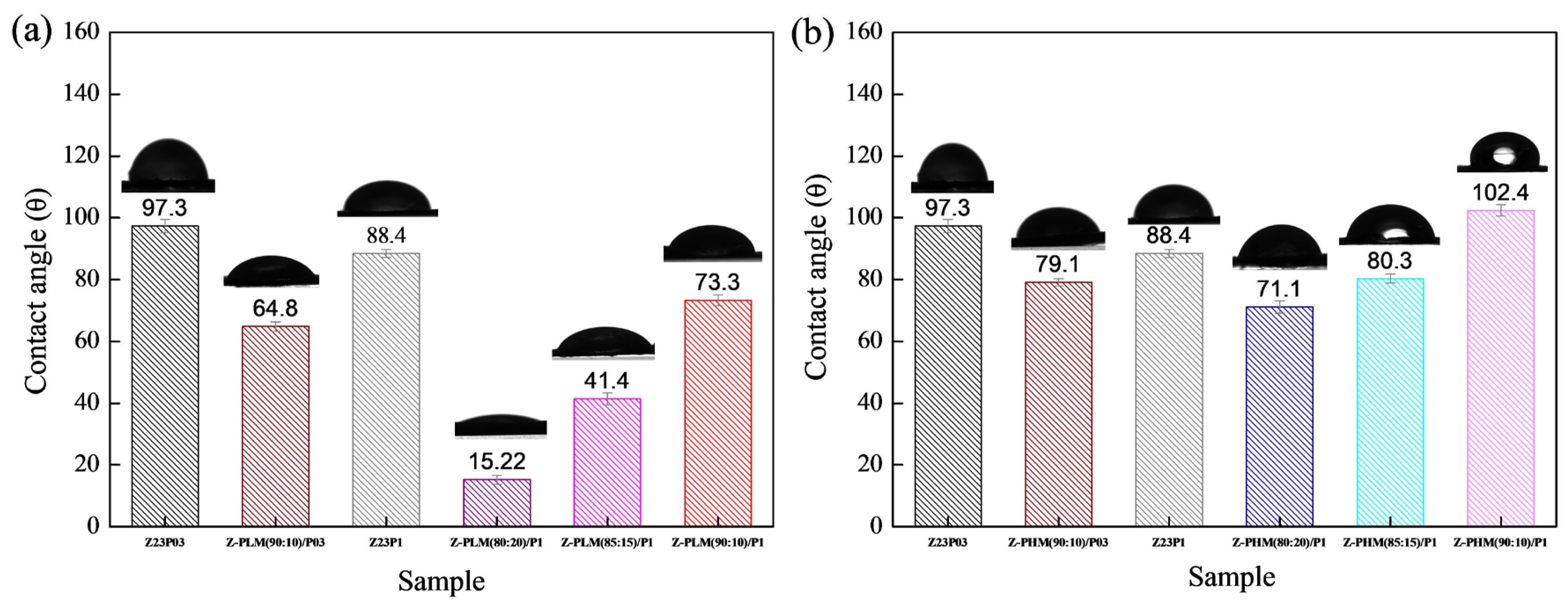Spinning a Sustainable Future: Electrospun Polysaccharide–Protein Fibers for Plant-Based Meat Innovation
Abstract
:1. Introduction
2. Materials and Methods
2.1. Materials and Solution Preparation
2.1.1. Alginate/PEO Solutions
2.1.2. Zein/Carrageenan/PEO Solutions
2.1.3. Zein/Pectin/PEO Solutions
2.2. Solution Characterization
2.3. Preparation of Polysaccharides/Protein Fibers
2.4. Characterization of Electrospun Fibers
2.5. Statistical Analyses
3. Results
3.1. Zein/Alginate/PEO
3.2. Zein/Carrageenan/PEO
3.3. Fibers Characterization
4. Conclusions
Author Contributions
Funding
Institutional Review Board Statement
Informed Consent Statement
Data Availability Statement
Acknowledgments
Conflicts of Interest
References
- Mohammed, A.S.A.; Naveed, M.; Jost, N. Polysaccharides; Classification, Chemical Properties, and Future Perspective Applications in Fields of Pharmacology and Biological Medicine (A Review of Current Applications and Upcoming Potentialities). J. Polym. Environ. 2021, 29, 2359–2371. [Google Scholar] [CrossRef] [PubMed]
- Tapia-Hernández, J.A.; Rodríguez-Felix, F.; Juárez-Onofre, J.E.; Ruiz-Cruz, S.; Robles-García, M.A.; Borboa-Flores, J.; Wong-Corral, F.J.; Cinco-Moroyoqui, F.J.; Castro-Enríquez, D.D.; Del-Toro-Sánchez, C.L. Zein-Polysaccharide Nanoparticles as Matrices for Antioxidant Compounds: A Strategy for Prevention of Chronic Degenerative Diseases. Food Res. Int. 2018, 111, 451–471. [Google Scholar] [CrossRef] [PubMed]
- Mendes, A.C.; Stephansen, K.; Chronakis, I.S. Electrospinning of Food Proteins and Polysaccharides. Food Hydrocoll. 2017, 68, 53–68. [Google Scholar] [CrossRef]
- Saquing, C.D.; Tang, C.; Monian, B.; Bonino, C.A.; Manasco, J.L.; Alsberg, E.; Khan, S.A. Alginate–Polyethylene Oxide Blend Nanofibers and the Role of the Carrier Polymer in Electrospinning. Ind. Eng. Chem. Res. 2013, 52, 8692–8704. [Google Scholar] [CrossRef]
- Bonino, C.A.; Efimenko, K.; Jeong, S.I.; Krebs, M.D.; Alsberg, E.; Khan, S.A. Three-Dimensional Electrospun Alginate Nanofiber Mats via Tailored Charge Repulsions. Small 2012, 8, 1928–1936. [Google Scholar] [CrossRef]
- Bonino, C.A.; Krebs, M.D.; Saquing, C.D.; Jeong, S.I.; Shearer, K.L.; Alsberg, E.; Khan, S.A. Electrospinning Alginate-Based Nanofibers: From Blends to Crosslinked Low Molecular Weight Alginate-Only Systems. Carbohydr. Polym. 2011, 85, 111–119. [Google Scholar] [CrossRef]
- Ramos, S.d.P.; da Trindade, L.G.; Mazzo, T.M.; Longo, E.; Bonsanto, F.P.; de Rosso, V.V.; Braga, A.R.C. Electrospinning Composites as Carriers of Natural Pigment: Screening of Polymeric Blends. Processes 2022, 10, 2737. [Google Scholar] [CrossRef]
- Ramos, S.d.P.; Giaconia, M.A.; Assis, M.; Jimenez, P.C.; Mazzo, T.M.; Longo, E.; De Rosso, V.V.; Braga, A.R.C.C. Uniaxial and Coaxial Electrospinning for Tailoring Jussara Pulp Nanofibers. Molecules 2021, 26, 1206. [Google Scholar] [CrossRef]
- Cirillo, V.; Guarino, V.; Ambrosio, L. Design of Bioactive Electrospun Scaffolds for Bone Tissue Engineering. J. Appl. Biomater. Funct. Mater. 2012, 10, 223–228. [Google Scholar] [CrossRef]
- Yapo, B.M. Pectic Substances: From Simple Pectic Polysaccharides to Complex Pectins—A New Hypothetical Model. Carbohydr. Polym. 2011, 86, 373–385. [Google Scholar] [CrossRef]
- Pelloux, J.; Rusterucci, C.; Mellerowicz, E. New Insights into Pectin Methylesterase Structure and Function. Trends Plant Sci. 2007, 12, 267–277. [Google Scholar] [CrossRef] [PubMed]
- Yapo, B.M. Rhamnogalacturonan-I: A Structurally Puzzling and Functionally Versatile Polysaccharide from Plant Cell Walls and Mucilages. Polym. Rev. 2011, 51, 391–413. [Google Scholar] [CrossRef]
- Rockwell, P.L.; Kiechel, M.A.; Atchison, J.S.; Toth, L.J.; Schauer, C.L. Various-Sourced Pectin and Polyethylene Oxide Electrospun Fibers. Carbohydr. Polym. 2014, 107, 110–118. [Google Scholar] [CrossRef] [PubMed]
- Raza, Z.A.; Munim, S.A.; Ayub, A. Recent Developments in Polysaccharide-Based Electrospun Nanofibers for Environmental Applications. Carbohydr. Res. 2021, 510, 108443. [Google Scholar] [CrossRef]
- Deng, Y.; Zhang, X.; Zhao, Y.; Liang, S.; Xu, A.; Gao, X.; Deng, F.; Fang, J.; Wei, S. Peptide-Decorated Polyvinyl Alcohol/Hyaluronan Nanofibers for Human Induced Pluripotent Stem Cell Culture. Carbohydr. Polym. 2014, 101, 36–39. [Google Scholar] [CrossRef]
- Ahire, J.J.; Robertson, D.D.; van Reenen, A.J.; Dicks, L.M.T. Polyethylene Oxide (PEO)-Hyaluronic Acid (HA) Nanofibers with Kanamycin Inhibits the Growth of Listeria Monocytogenes. Biomed. Pharmacother. 2017, 86, 143–148. [Google Scholar] [CrossRef]
- Stijnman, A.C.; Bodnar, I.; Hans Tromp, R. Electrospinning of Food-Grade Polysaccharides. Food Hydrocoll. 2011, 25, 1393–1398. [Google Scholar] [CrossRef]
- Giaconia, M.A.; Ramos, S.d.P.; Neves, B.V.; Almeida, L.; Costa-Lotufo, L.; de Rosso, V.V.; Braga, A.R.C. Nanofibers of Jussara Pulp: A Tool to Prevent the Loss of Thermal Stability and the Antioxidant Activity of Anthocyanins after Simulated Digestion. Processes 2022, 10, 2343. [Google Scholar] [CrossRef]
- Ramos, S.D.P.; Giaconia, M.A.; Do Marco, J.T.; Paiva, R.d.S.; De Rosso, V.V.; Lemes, A.C.; Egea, M.B.; Assis, M.; Mazzo, T.M.; Longo, E.; et al. Development and Characterization of Electrospun Nanostructures Using Polyethylene Oxide: Potential Means for Incorporation of Bioactive Compounds. Colloids Interfaces 2020, 4, 14. [Google Scholar] [CrossRef]
- Giaconia, M.A.; Ramos, S.D.P.; Fratelli, C.; Assis, M.; Mazzo, T.M.; Longo, E.; de Rosso, V.V.; Braga, A.R.C.; Ramos, P.; Fratelli, C.; et al. Fermented Jussara: Evaluation of Nanostructure Formation, Bioaccessibility, and Antioxidant Activity. Front. Bioeng. Biotechnol. 2022, 10, 1–11. [Google Scholar] [CrossRef]
- Bodillard, J.; Pattappa, G.; Pilet, P.; Weiss, P.; Réthoré, G. Functionalisation of Polysaccharides for the Purposes of Electrospinning: A Case Study Using HPMC and Si-HPMC. Gels 2015, 1, 44–57. [Google Scholar] [CrossRef] [PubMed]
- Jaski, A.C.; Schmitz, F.; Horta, R.P.; Cadorin, L.; da Silva, B.J.G.; Andreaus, J.; Paes, M.C.D.; Riegel-Vidotti, I.C.; Zimmermann, L.M. Zein—a Plant-Based Material of Growing Importance: New Perspectives for Innovative Uses. Ind. Crops Prod. 2022, 186, 115250. [Google Scholar] [CrossRef]
- Kasaai, M.R. Zein and Zein -Based Nano-Materials for Food and Nutrition Applications: A Review. Trends Food Sci. Technol. 2018, 79, 184–197. [Google Scholar] [CrossRef]
- Pérez-Guzmán, C.J.; Castro-Muñoz, R. A Review of Zein as a Potential Biopolymer for Tissue Engineering and Nanotechnological Applications. Processes 2020, 8, 1376. [Google Scholar] [CrossRef]
- Wilkinson, C.; Dijksterhuis, G.B.; Minekus, M. From Food Structure to Texture. Trends Food Sci. Technol. 2000, 11, 442–450. [Google Scholar] [CrossRef]
- Lu, X.; Chen, J.; Guo, Z.; Zheng, Y.; Rea, M.C.; Su, H.; Zheng, X.; Zheng, B.; Miao, S. Using Polysaccharides for the Enhancement of Functionality of Foods: A Review. Trends Food Sci. Technol. 2019, 86, 311–327. [Google Scholar] [CrossRef]
- Tolstoguzov, V. Some Thermodynamic Considerations in Food Formulation. Food Hydrocoll. 2003, 17, 1–23. [Google Scholar] [CrossRef]
- He, H.; Kara, Y.; Molnar, K. Effect of Needle Characteristic on Fibrous PEO Produced by Electrospinning. Resolut. Discov. 2019, 4, 7–11. [Google Scholar] [CrossRef]
- Ali, S.; Khatri, Z.; Oh, K.W.; Kim, I.-S.; Kim, S.H. Zein/Cellulose Acetate Hybrid Nanofibers: Electrospinning and Characterization. Macromol. Res. 2014, 22, 971–977. [Google Scholar] [CrossRef]
- Liu, J.; Chen, R.; Wang, C.; Zhao, Y.; Chu, F. Synthesis and Characterization of Polyethylene Glycol-Phenol-Formaldehyde Based Polyurethane Composite. Sci. Rep. 2019, 9, 19545. [Google Scholar] [CrossRef]
- Vo, T.D.; Phung, T.M.; Truong, H.Q.D.H.; Nguyen, L.T.M.; Nguyen, O.H.; Le, P.M.L. Physical-Chemical and Electrochemical Properties of Sodium Ion Conducting Polymer Electrolyte Using Copolymer Poly(Vinylidene Fluoride- Hexafluoropropylene) (PVDF-HFP)/ Polyethylene Oxide (PEO). Sci. Technol. Dev. J. 2019, 22, 147–157. [Google Scholar] [CrossRef]
- Pereira, R.; Tojeira, A.; Vaz, D.C.; Mendes, A.; Bártolo, P. Preparation and Characterization of Films Based on Alginate and Aloe Vera. Int. J. Polym. Anal. Charact. 2011, 16, 449–464. [Google Scholar] [CrossRef]
- Han, J.; Zhou, Z.; Yin, R.; Yang, D.; Nie, J. Alginate–Chitosan/Hydroxyapatite Polyelectrolyte Complex Porous Scaffolds: Preparation and Characterization. Int. J. Biol. Macromol. 2010, 46, 199–205. [Google Scholar] [CrossRef]
- Venault, A.; Chang, C.-Y.; Tsai, T.-C.; Chang, H.-Y.; Bouyer, D.; Lee, K.-R.; Chang, Y. Surface Zwitterionization of PVDF VIPS Membranes for Oil and Water Separation. J. Membr. Sci. 2018, 563, 54–64. [Google Scholar] [CrossRef]
- De Almeida, C.B.; Corradini, E.; Forato, L.A.; Fujihara, R.; Filho, J.F.L. Microstructure and Thermal and Functional Properties of Biodegradable Films Produced Using Zein. Polimeros 2018, 28, 30–37. [Google Scholar] [CrossRef]
- Stipanelov Vrandečić, N.; Erceg, M.; Andričić, B.; Blanco, I.; Bottino, F.A. Characterization of Poly(Ethylene Oxide) Modified with Different Phenyl Hepta Isobutyl Polyhedral Oligomeric Silsesquioxanes. J. Therm. Anal. Calorim. 2020, 142, 1863–1875. [Google Scholar] [CrossRef]
- Marangoni Júnior, L.; Rodrigues, P.R.; da Silva, R.G.; Vieira, R.P.; Alves, R.M.V. Sustainable Packaging Films Composed of Sodium Alginate and Hydrolyzed Collagen: Preparation and Characterization. Food Bioprocess Technol. 2021, 14, 2336–2346. [Google Scholar] [CrossRef]
- Chen, H.; Su, J.; Brennan, C.S.; Van der Meeren, P.; Zhang, N.; Tong, Y.; Wang, P. Recent Developments of Electrospun Zein Nanofibres: Strategies, Fabrication and Therapeutic Applications. Mater. Today Adv. 2022, 16, 100307. [Google Scholar] [CrossRef]
- Deng, L.; Li, Y.; Feng, F.; Zhang, H. Study on Wettability, Mechanical Property and Biocompatibility of Electrospun Gelatin/Zein Nanofibers Cross-Linked by Glucose. Food Hydrocoll. 2019, 87, 1–10. [Google Scholar] [CrossRef]
- Hegazy, D.E.; Mahmoud, G.A. Radiation Synthesis and Characterization of Polyethylene Oxide/ Chitosan- Silver Nano Composite for Biomedical Applications. Arab J. Nucl. Sci. Appl. 2014, 47, 1–14. [Google Scholar]
- Arockia Mary, I.; Selvanayagam, S.; Selvasekarapandian, S.; Srikumar, S.R.; Ponraj, T.; Moniha, V. Lithium Ion Conducting Membrane Based on K-Carrageenan Complexed with Lithium Bromide and Its Electrochemical Applications. Ionics 2019, 25, 5839–5855. [Google Scholar] [CrossRef]
- Moreno, M.A.; Orqueda, M.E.; Gómez-Mascaraque, L.G.; Isla, M.I.; López-Rubio, A. Crosslinked Electrospun Zein-Based Food Packaging Coatings Containing Bioactive Chilto Fruit Extracts. Food Hydrocoll. 2019, 95, 496–505. [Google Scholar] [CrossRef]
- Salmasi, S.S.; Ehsani, M.; Zandi, M.; Saeed, M.; Sabeti, M. Polysaccharide-Based (Kappa Carrageenan/Carboxymethyl Chitosan) Nanofibrous Membrane Loaded with Antifibrinolytic Drug for Rapid Hemostasis- in Vitro and in Vivo Evaluation. Int. J. Biol. Macromol. 2023, 247, 125786. [Google Scholar] [CrossRef]
- Esmaeili, M.S.; Varzi, Z.; Taheri-Ledari, R.; Maleki, A. Preparation and Study of the Catalytic Application in the Synthesis of Xanthenedione Pharmaceuticals of a Hybrid Nano-System Based on Copper, Zinc and Iron Nanoparticles. Res. Chem. Intermed. 2021, 47, 973–996. [Google Scholar] [CrossRef]
- Joel, J.M.; Barminas, J.; Riki, E.Y.; Yelwa, J.; Friday, E. Extraction and Characterization of Hydrocolloid Pectin from Goron Tula (Azanza Garckeana) Fruit. World Sci. News 2018, 101, 157–171. [Google Scholar]
- Nesic, A.; Meseldzija, S.; Cabrera-Barjas, G.; Onjia, A. Novel Biocomposite Films Based on High Methoxyl Pectin Reinforced with Zeolite Y for Food Packaging Applications. Foods 2022, 11, 360. [Google Scholar] [CrossRef]
- Zhang, W.; Liang, Y.; Luo, W.; Fang, Y. Effects of Clay-modifying Agents on the Morphology and Properties of Poly(Methyl Methacrylate)/Clay Nanocomposites Synthesized via Γ-ray Irradiation Polymerization. J. Polym. Sci. A Polym. Chem. 2003, 41, 3218–3226. [Google Scholar] [CrossRef]
















| Composition | Voltage (kV) | Feeding Rate (μL/h) | TCD (cm) | Visual Observation at Needle | Microscopic Observation on Collector |
|---|---|---|---|---|---|
| Alginate (2 wt %) | 18 | 1800 | 15 | Drops | None |
| Alginate (2 wt %) | 22 | 2000 | 15 | Drops | None |
| Alginate/PEO (20:80) | 18 | 1800 | 15 | Drops | None |
| Alginate/PEO (20:80) | 22 | 2000 | 15 | Drops | None |
| Alginate/PEO (40:60) | 18 | 1800 | 15 | Drops | None |
| Alginate/PEO (40:60) | 22 | 2000 | 15 | Drops | None |
| Alginate/PEO (50:50) | 18 | 1800 | 15 | Drops | None |
| Alginate/PEO (50:50) | 22 | 2000 | 15 | Drops | None |
| Composition | Sample | Voltage (kV) | Feeding Rate (μL/h) | TCD (cm) | Visual Observation at Needle | Microscopic Observation on Collector |
|---|---|---|---|---|---|---|
| Zein 23%/PEO 0.3% | Z23P03 | 24 | 2000 | 12 | Jet | Fibers |
| Zein/alginate (80:20)/PEO 0.3% | Z-A/(80:20)/P03 | 22 | 2000 | 15 | Jet and drops | None |
| Zein/alginate (80:20)/PEO 0.3% | Z-A/(80:20)/P03 | 24 | 2000 | 12 | Jet and drops | None |
| Zein/alginate (85:15)/PEO 0.3% | Z-A/(85:15)/P03 | 22 | 2000 | 15 | Jet and drops | None |
| Zein/alginate (85:15)/PEO 0.3% | Z-A/(85:15)/P03 | 24 | 2000 | 12 | Jet and drops | None |
| Zein/alginate (90:10)/PEO 0.3% | Z-A/(90:10)/P03 | 22 | 2000 | 15 | Jet and drops | None |
| Zein/alginate (90:10)/PEO 0.3% | Z-A/(90:10)/P03 | 24 | 2000 | 12 | Jet | Fibers |
| Zein 23%/PEO 1% | Z23P1 | 24 | 2000 | 12 | Jet | Fibers |
| Zein/alginate (80:20)/PEO 1% | Z-A/(80:20)/P1 | 24 | 2000 | 12 | Jet | Fibers |
| Zein/alginate (85:15)/PEO 1% | Z-A/(85:15)/P1 | 24 | 2000 | 12 | Jet | Fibers |
| Zein/alginate (90:10)/PEO 1% | Z-A/(90:10)/P1 | 24 | 2000 | 12 | Jet | Fibers |
| Parameter | Z23P03 | Z23P1 | Z-A (90:10)/P 03 | Z-A (90:10)/P 1 |
|---|---|---|---|---|
| k (Pa·sn) | 0.120 c ± 0.002 | 0.383 b ± 0.008 | 0.140 c ± 0.130 | 16.20 a ± 2.633 |
| n (−) | 0.932 a ± 0.0 | 0.880 b ± 0.0 | 0.876 b± 0.13 | 0.490 c ± 0.03 |
| R2 | 99.99 | 99.93 | 99.81 | 99.80 |
| Viscosity 10 s−1 (mPa·s) | 95.6 c ± 1.70 | 252.8 b ± 2.83 | 143.5 c ± 70.19 | 5421.2 a ± 880.99 |
| Composition | Sample | Visual Observation at Needle | Microscopic Observation on Collector | k (Pa·sn) | n (-) | R2 | Viscosity 10 s−1 (mPa·s) |
|---|---|---|---|---|---|---|---|
| Zein 23%/PEO 0.3% | Z23P03 | Jet | Fibers | 0.120 d ± 0.002 | 0.932 a ± 0.0 | 99.99 | 95.58 d ± 1.70 |
| Zein/carrageenan (80:20)/PEO 0.3% | Z-C(80:20)/P03 | Jet and drops | None | - | - | - | - |
| Zein/carrageenan (85:15)/PEO 0.3% | Z-C(85:15)/P03 | Jet and drops | None | - | - | - | - |
| Zein/carrageenan (90:10)/PEO 0.3% | Z-C(90:10)/P03 | Jet | Fibers | 0.355 b ± 0.013 | 0.745 d ± 0.01 | 99.88 | 206.0 b ± 13.56 |
| Zein 23%/PEO 1% | Z23P1 | Jet | Fibers | 0.383 a ± 0.008 | 0.880 b ± 0.0 | 99.93 | 252.8 a ± 2.83 |
| Zein/carrageenan (80:20)/PEO 1% | Z-C(80:20)/P1 | Jet | Fibers | - | - | - | - |
| Zein/carrageenan (85:15)/PEO 1% | Z-C(85:15)/P1 | Jet | Fibers | - | - | - | - |
| Zein/carrageenan (90:10)/PEO 1% | Z-C(90:10)/P1 | Jet | Fibers | 0.272 c ± 0.014 | 0.872 c ± 0.01 | 99.95 | 178.8 c ± 6.83 |
| Composition | Voltage (kV) | Visual Observation at Needle | Microscopic Observation on Collector | k (Pa·sn) | n (-) | R2 | Viscosity 10 s−1 (mPa·s) |
|---|---|---|---|---|---|---|---|
| Zein 23%/PEO 0.3% | Z23P03 | Jet | Fibers | 0.120 d ± 0.002 | 0.932 a ± 0.0 | 99.99 | 95.58 d ± 1.70 |
| Zein/HM pectin (80:20)/PEO 0.3% | Z-PHM(80:20)/P03 | Jet and drops | None | - | - | - | - |
| Zein/HM pectin (85:15)/PEO 0.3% | Z-PHM(85:15)/P03 | Jet and drops | None | - | - | - | - |
| Zein/HM pectin (90:10)/PEO 0.3% | Z-PHM(90:10)/P03 | Jet | Fibers | 0.85761 b ± 0.581 | 0.573 d ± 0.11 | 95.91 | 394.1 c ± 80.37 |
| Zein/LM pectin (80:20)/PEO 0.3% | Z-PLM(80:20)/P03 | Jet and drops | None | - | - | - | - |
| Zein/LM pectin (85:15)/PEO 0.3% | Z-PLM(85:15)/P03 | Jet and drops | None | - | - | - | - |
| Zein/LM pectin (90:10)/PEO 0.3% | Z-PLM(90:10)/P03 | Jet | Fibers | - | - | - | 2021.0 a ± 977.38 |
| Zein 23%/PEO 1% | Z23P1 | Jet | Fibers | 0.383 c ± 0.008 | 0.880 b ± 0.0 | 99.93 | 252.8 c ± 2.83 |
| Zein/HM pectin (80:20)/PEO 1% | Z-PHM(80:20)/P1 | Jet | Fibers | - | - | - | - |
| Zein/HM pectin (85:15)/PEO 1% | Z-PHM(85:15)/P1 | Jet | Fibers | - | - | - | - |
| Zein/HM pectin (90:10)/PEO 1% | Z-PHM(90:10)/P1 | Jet | Fibers | 3.82 a ± 0.327 | 0.658 c ± 0.02 | 99.97 | 1742.6 a ± 101.76 |
| Zein/LM pectin (80:20)/PEO 1% | Z-PLM(80:20)/P1 | Jet | Fibers | - | - | - | - |
| Zein/LM pectin (85:15)/PEO 1% | Z-PLM(85:15)/P1 | Jet | Fibers | - | - | - | - |
| Zein/LM pectin (90:10)/PEO 1% | Z-PLM(90:10)/P1 | Jet | Fibers | 4.90 a ± 1.114 | 0.399 e ± 0.06 | 86.13 | 991.5 b ± 52.09 |
Disclaimer/Publisher’s Note: The statements, opinions and data contained in all publications are solely those of the individual author(s) and contributor(s) and not of MDPI and/or the editor(s). MDPI and/or the editor(s) disclaim responsibility for any injury to people or property resulting from any ideas, methods, instructions or products referred to in the content. |
© 2024 by the authors. Licensee MDPI, Basel, Switzerland. This article is an open access article distributed under the terms and conditions of the Creative Commons Attribution (CC BY) license (https://creativecommons.org/licenses/by/4.0/).
Share and Cite
da Trindade, L.G.; Zanchet, L.; Bonsanto, F.P.; Braga, A.R.C. Spinning a Sustainable Future: Electrospun Polysaccharide–Protein Fibers for Plant-Based Meat Innovation. Foods 2024, 13, 2962. https://doi.org/10.3390/foods13182962
da Trindade LG, Zanchet L, Bonsanto FP, Braga ARC. Spinning a Sustainable Future: Electrospun Polysaccharide–Protein Fibers for Plant-Based Meat Innovation. Foods. 2024; 13(18):2962. https://doi.org/10.3390/foods13182962
Chicago/Turabian Styleda Trindade, Letícia G., Letícia Zanchet, Fabiana Perrechil Bonsanto, and Anna Rafaela Cavalcante Braga. 2024. "Spinning a Sustainable Future: Electrospun Polysaccharide–Protein Fibers for Plant-Based Meat Innovation" Foods 13, no. 18: 2962. https://doi.org/10.3390/foods13182962








